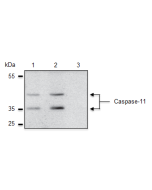Cookie Policy: This site uses cookies to improve your experience. You can find out more about our use of cookies in our Privacy Policy. By continuing to browse this site you agree to our use of cookies.
AdipoGen Life Sciences
anti-Caspase-4 /11 (p20), mAb (Flamy-1) (Biotin)

| Product Details | |
|---|---|
| Synonyms | Caspase-11 (mouse); Caspase-4 (human); ICE(rel)-II (human); Protease ICH-2 (human); Protease TX (human); Protease ICH-3 (mouse) |
| Product Type | Monoclonal Antibody |
| Properties | |
| Clone | Flamy-1 |
| Isotype | Mouse IgG2bκ |
| Source/Host | Purified from concentrated hybridoma tissue culture supernatant. |
| Immunogen/Antigen | Recombinant mouse Caspase-11 (aa 81-373). |
| Label/Conjugates | Biotin |
| Application |
Western Blot: (1μg/ml) Immunoprecipitation |
| Crossreactivity |
Human Mouse |
| Specificity | Recognizes endogenous full-length protein and activated (p20) fragment of mouse and human caspase-4/11. Does not detect human Caspase-5. |
| Purity | ≥95% (SDS-PAGE) |
| Purity Detail | Protein G-affinity purified. |
| Concentration | 1mg/ml |
| Formulation | Liquid. In PBS containing 0.02% sodium azide. |
| Shipping and Handling | |
| Shipping | BLUE ICE |
| Short Term Storage | +4°C |
| Long Term Storage | -20°C |
| Handling Advice |
After opening, prepare aliquots and store at -20°C. Avoid freeze/thaw cycles. |
| Use/Stability | Stable for at least 1 year after receipt when stored at -20°C. |
| Documents | |
| MSDS |
 Download PDF Download PDF |
| Product Specification Sheet | |
| Datasheet |
 Download PDF Download PDF |
Inflammatory caspases (also known as group I caspases) are encoded by three main genes in humans, caspase-1, caspase-4 and caspase-5 and three main genes in mouse, caspase-1, caspase-11 and caspase-12. Caspase-11 is the murine orthologue of human caspase-4 and -5. Murine caspase-11 is a poorly characterized member of the caspase-1 subfamily. Caspase-11-deficient embryonic fibroblasts are resistant to apoptosis induced by ectopic expression of caspase-1, suggesting that caspase-11 is an upstream activator of caspase-1. Unlike caspase-1, the expression of caspase-11 is LPS-inducible and it is reasonable to postulate that other members of the family are regulated at the transcriptional or translational level by extracellular stimuli.
Recently caspase-11 has been shown to be required for activation of the Nlrp3 inflammasome upon E. coli, V. cholerae and C. rodentium infection. The upstream activators of caspase-11 are TLR4 and TRIF, that modulate enteropathogen-induced inflammasome activation by promoting caspase-11 expression and activation. Formation of ASC foci (specks), a measure of NLRP3/ASC complex formation, requires caspase-11 but not caspase-1 indicating that caspase-11 acts upstream of the NLRP3/ASC complex.
- NLRP3 inflammasome activation downstream of cytoplasmic LPS recognition by both caspase-4 and caspase-5: P.J. Baker, et al.; Eur. J. Immunol. 45, 2918 (2015)
- Generation of Genetic Knockouts in Myeloid Cell Lines Using a Lentiviral CRISPR/Cas9 System: P.J. Baker & S.L. Masters; Methods Mol. Biol. 1714, 41 (2018)
- Guanylate-binding protein 5 licenses caspase11 for Gasdermin-D mediated host resistance to Brucella abortus infection: D.M. Cerqueira, et al.; PLoS Pathogens 14, e1007519 (2018)
- Intestinal restriction of Salmonella Typhimurium requires caspase-1 and caspase-11 epithelial intrinsic inflammasomes: S.M. Crowley, et al.; PLoS Pathog. 16, e1008498 (2020)
- STING regulates metabolic reprogramming in macrophages via HIF-1α during Brucella infection: M.T.R. Gomes, et al.; PLoS Pathog 17, e1009597 (2021)
- NLRP6-caspase 4 inflammasome activation in response to cariogenic bacterial lipoteichoic acid in human dental pulp inflammation: X.X. Tian, et al.; Int. Endodont. J. 54, 916 (2021)






